PHP and SOAP: How to handle data verification and correction
Introduction:
In the Internet era, data interaction and processing are becoming more and more important. In web applications, we usually use SOAP (Simple Object Access Protocol) for data interaction. In the process of data interaction, data verification and correction are particularly important. This article will introduce how to use PHP and SOAP to perform data verification and correction in data interaction, and give detailed code examples.
1. The importance of data verification
Data verification is a key step to ensure the accuracy and integrity of data. In web applications, data verification can prevent malicious attacks and incorrect inputs, protecting the security and reliability of data. At the same time, data verification also helps improve system performance and execution efficiency.
2. Use SOAP for data interaction
SOAP is an XML-based protocol used for remote procedure calls (RPC) between Web services. It uses XML format to encapsulate data and transmit it through HTTP or other protocols. In PHP, we can use SOAP extensions to achieve data interaction.
The following is a simple PHP SOAP client code example:
<?php $wsdl = "http://example.com/webservice?wsdl"; $client = new SoapClient($wsdl); // 调用远程方法 $result = $client->remoteMethod($param1, $param2); // 处理返回结果 echo $result; ?>
In this example, we use the SoapClient class to instantiate a SOAP client and specify the WSDL file of the remote web service . We can then use the $client object to call the remote method and handle the return result.
3. Basic principles of data verification
The basic principle of data verification is to verify data based on predefined rules and constraints. Common data verification includes verification of type, length, format, etc. In PHP, we can use regular expressions, built-in functions, and custom functions for data verification.
The following is an example of a simple PHP data validation function:
<?php
function validateEmail($email) {
// 通过正则表达式验证电子邮件格式
if (preg_match("/^[a-zA-Z0-9._%+-]+@[a-zA-Z0-9.-]+.[a-zA-Z]{2,}$/", $email)) {
return true;
}
return false;
}
$email = "example@example.com";
if (validateEmail($email)) {
echo "Email格式正确";
} else {
echo "Email格式不正确";
}
?>In this example, we define a validateEmail function that uses regular expressions to match email formats. Then, we call this function and output the corresponding message based on the return result.
4. Implementation of data correction
Data correction is the adjustment and correction of input data to ensure that it conforms to predefined rules and constraints. In PHP, we can use built-in functions and custom functions to implement data correction.
The following is an example of a simple PHP data correction function:
<?php
function sanitizeInput($input) {
// 过滤非法字符和标签
$input = strip_tags($input);
$input = htmlspecialchars($input);
// 去除首尾空格
$input = trim($input);
return $input;
}
$input = "<script>alert('XSS攻击');</script>";
$input = sanitizeInput($input);
echo $input;
?>In this example, we define a sanitizeInput function, use the strip_tags function and htmlspecialchars function to filter illegal characters and tags, and then use The trim function removes leading and trailing spaces. Finally, we call this function and print the result.
Conclusion:
In Web applications, data checksum correction is very important. By using PHP and SOAP technology, we can implement data verification and correction and ensure the accuracy and completeness of the data. This article introduces the methods and techniques of data verification and correction in data interaction through detailed code examples. I hope readers can get some inspiration and help from it.
The above is the detailed content of PHP and SOAP: How to handle checksum correction of data. For more information, please follow other related articles on the PHP Chinese website!
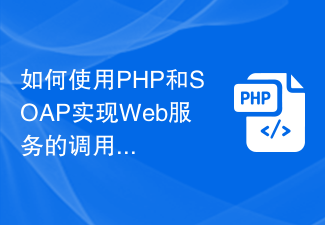 如何使用PHP和SOAP实现Web服务的调用和开发Jun 25, 2023 am 09:59 AM
如何使用PHP和SOAP实现Web服务的调用和开发Jun 25, 2023 am 09:59 AM在Web开发领域中,Web服务是一种非常重要的技术,它可以使不同的应用程序之间互相通信,从而构建更加复杂和强大的系统。在本文中,我们将深入探讨如何使用PHP和SOAP实现Web服务的调用和开发。SOAP(SimpleObjectAccessProtocol)是一种基于XML的协议,它用于在不同的应用程序之间进行信息交换。SOAP是一个重要的Web服务标
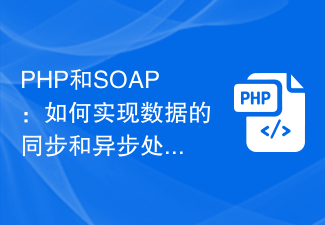 PHP和SOAP:如何实现数据的同步和异步处理Jul 28, 2023 pm 03:29 PM
PHP和SOAP:如何实现数据的同步和异步处理Jul 28, 2023 pm 03:29 PMPHP和SOAP:如何实现数据的同步和异步处理引言:在现代Web应用程序中,数据的同步和异步处理变得越来越重要。同步处理指的是一次只处理一个请求,并等待该请求完成后再处理下一个请求;而异步处理则是同时处理多个请求,并不等待某个请求的完成。在本文中,我们将介绍如何使用PHP和SOAP来实现数据的同步和异步处理。一、SOAP简介SOAP(SimpleObjec
 PHP和SOAP:如何实现远程过程调用(RPC)Jul 29, 2023 pm 02:45 PM
PHP和SOAP:如何实现远程过程调用(RPC)Jul 29, 2023 pm 02:45 PMPHP和SOAP:如何实现远程过程调用(RPC)简介:近年来,随着分布式系统的兴起,远程过程调用(RemoteProcedureCall,RPC)在Web开发中被广泛采用。本文将介绍如何使用PHP和SOAP实现RPC,以及通过代码示例演示其用法。一、什么是远程过程调用(RPC)?远程过程调用(RemoteProcedureCall,RPC)是一种通信
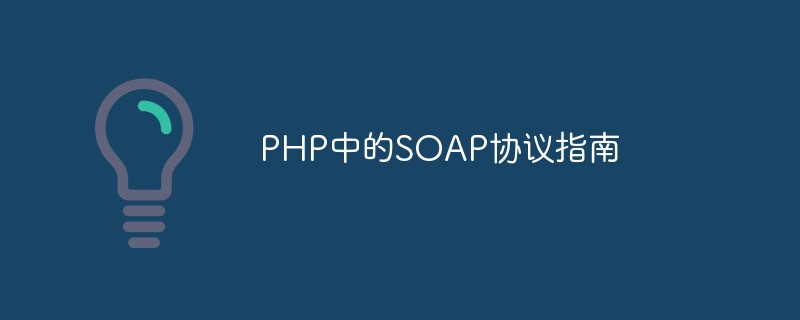 PHP中的SOAP协议指南May 20, 2023 pm 07:10 PM
PHP中的SOAP协议指南May 20, 2023 pm 07:10 PM随着互联网技术的不断发展,越来越多的企业级应用需要向其它应用程序提供接口以实现数据和业务的交互。在这种情况下,我们需要一种可靠的协议来传输数据并确保数据的完整性和安全性。SOAP(SimpleObjectAccessProtocol)就是一种基于XML的协议,可用于在Web环境中实现应用之间的通信。而PHP作为一种流行的Web编程语言,
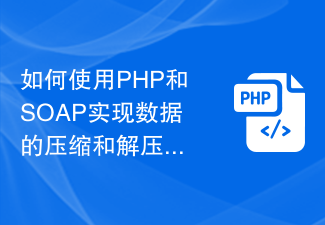 如何使用PHP和SOAP实现数据的压缩和解压缩Jul 29, 2023 pm 12:28 PM
如何使用PHP和SOAP实现数据的压缩和解压缩Jul 29, 2023 pm 12:28 PM如何使用PHP和SOAP实现数据的压缩和解压缩导言:在现代互联网应用中,数据的传输是非常常见的操作,然而,随着互联网应用的不断发展,数据量的增加和传输速度的要求,合理地使用数据压缩和解压缩技术成为了一个非常重要的话题。在PHP开发中,我们可以使用SOAP(SimpleObjectAccessProtocol)协议来实现数据的压缩和解压缩。本文将介绍如何
 如何使用PHP和SOAP实现Web服务的部署和发布Jul 28, 2023 pm 01:57 PM
如何使用PHP和SOAP实现Web服务的部署和发布Jul 28, 2023 pm 01:57 PM如何使用PHP和SOAP实现Web服务的部署和发布引言:在当今互联网时代,Web服务的部署和发布成为了一个非常重要的话题。PHP是一种流行的服务器端编程语言,而SOAP(SimpleObjectAccessProtocol)是一种XML协议,用于在Web服务之间进行通信。本文将向您介绍如何使用PHP和SOAP实现Web服务的部署和发布,并提供一些代码示
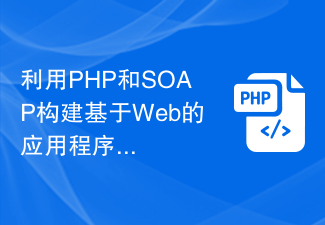 利用PHP和SOAP构建基于Web的应用程序的完整指南Jul 30, 2023 am 10:25 AM
利用PHP和SOAP构建基于Web的应用程序的完整指南Jul 30, 2023 am 10:25 AM利用PHP和SOAP构建基于Web的应用程序的完整指南在当今互联网的时代,基于Web的应用程序已经成为了管理和交互数据的重要工具。PHP作为一种强大的开发语言,可以与其他技术进行无缝集成,而SOAP(SimpleObjectAccessProtocol)作为一种基于XML的通信协议,为我们提供了一种简单、标准和可扩展的方法来构建Web服务。本文将为您提
 soap注入某sql2008服务器结合msf如何进行提权May 11, 2023 pm 09:25 PM
soap注入某sql2008服务器结合msf如何进行提权May 11, 2023 pm 09:25 PM在实际成功渗透过程中,漏洞的利用都是多个技术的融合,最新技术的实践,本次渗透利用sqlmap来确认注入点,通过sqlmap来获取webshell,结合msf来进行ms16-075的提权,最终获取了目标服务器的系统权限。本文算是漏洞利用的一个新的拓展,在常规Nday提权不成功的情况下,结合msf进行ms16-075成功提权的一个经典案例。1.1.1扫描soap注入漏洞1.使用awvs中的webservicesscanner进行漏洞扫描打开awvs,选择webservicesscanner进行漏洞扫


Hot AI Tools

Undresser.AI Undress
AI-powered app for creating realistic nude photos

AI Clothes Remover
Online AI tool for removing clothes from photos.

Undress AI Tool
Undress images for free

Clothoff.io
AI clothes remover

AI Hentai Generator
Generate AI Hentai for free.

Hot Article

Hot Tools

SAP NetWeaver Server Adapter for Eclipse
Integrate Eclipse with SAP NetWeaver application server.

PhpStorm Mac version
The latest (2018.2.1) professional PHP integrated development tool

DVWA
Damn Vulnerable Web App (DVWA) is a PHP/MySQL web application that is very vulnerable. Its main goals are to be an aid for security professionals to test their skills and tools in a legal environment, to help web developers better understand the process of securing web applications, and to help teachers/students teach/learn in a classroom environment Web application security. The goal of DVWA is to practice some of the most common web vulnerabilities through a simple and straightforward interface, with varying degrees of difficulty. Please note that this software

SublimeText3 English version
Recommended: Win version, supports code prompts!

ZendStudio 13.5.1 Mac
Powerful PHP integrated development environment






